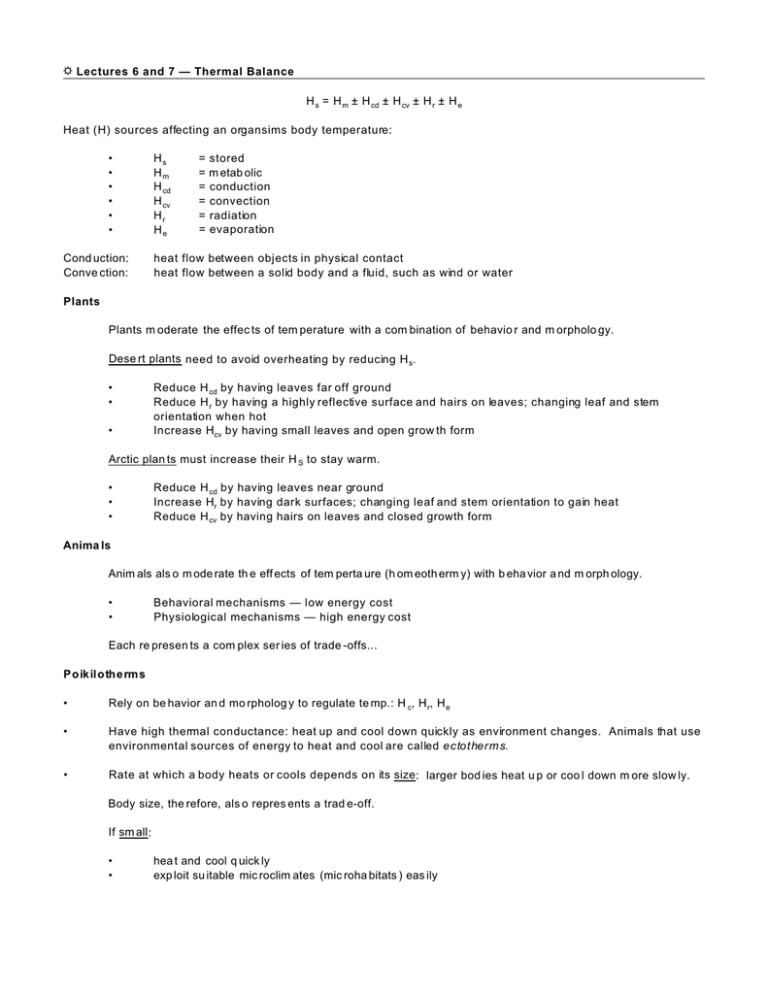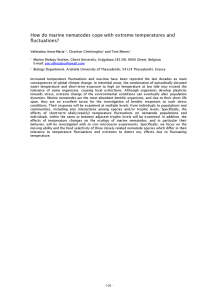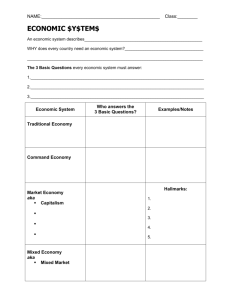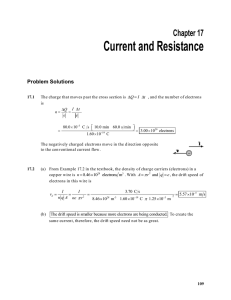` Lectures 6 and 7 — Thermal Balance Hs = Hm ± Hcd ± Hcv ± Hr
advertisement

' Lectures 6 and 7 — Thermal Balance H s = H m ± H cd ± H cv ± H r ± H e Heat (H) sources affecting an organsims body temperature: • • • • • • Cond uction: Conve ction: Hs Hm H cd H cv Hr He = = = = = = stored m etab olic conduction convection radiation evaporation heat flow between objects in physical contact heat flow between a solid body and a fluid, such as wind or water Plants Plants m oderate the effec ts of tem perature with a com bination of behavio r and m orpholo gy. Dese rt plants need to avoid overheating by reducing H s. • • • Reduce H cd by having leaves far off ground Reduce H r by having a highly reflective surface and hairs on leaves; changing leaf and stem orientation when hot Increase Hcv by having small leaves and open grow th form Arctic plan ts must increase their H S to stay warm. • • • Reduce H cd by having leaves near ground Increase Hr by having dark surfaces; changing leaf and stem orientation to gain heat Reduce H cv by having hairs on leaves and closed growth form Anima ls Anim als als o m ode rate th e eff ects of tem perta ure (h om eoth erm y) with b eha vior a nd m orph ology. • • Behavioral mechanisms — low energy cost Physiological mechanisms — high energy cost Each re presen ts a com plex ser ies of trade -offs... Poikil o th erms • Rely on be havior an d mo rpholog y to regulate te mp.: H c, H r, H e • Have high thermal conductance: heat up and cool down quickly as environment changes. Animals that use environmental sources of energy to heat and cool are called ectotherms. • Rate at which a body heats or cools depends on its size: larger bod ies heat u p or coo l down m ore slow ly. Body size, the refore, als o repres ents a trad e-off. If sm all: • • hea t and cool q uick ly exp loit su itable mic roclim ates (mic roha bitats ) eas ily If large • • • • hea t and cool s lowly exploit fewer microclimates distribution can be limited to places with narrower temperature range Larger-bodied poikilotherms have some protection from extremes and can travel for longer time periods mor e freely. Ectotherms • Activity levels depend on environmental temperature; consequently, activity is restricted to certain parts of day and c ertain sea sons o f year. In Aqua tic Environ ments Large water bodies have narrow range of temperatures and are ideal for poikilotherms, such as fish. • • • Consequently, thermoregulatory mechanisms in aquatic poikilotherms are not well developed Little ability to tolerate changes in tem perature Body tem perature s do no t differ app reciably from the environ men t. In Terrestrial Environ ments Body temperatures show little relationship to environmental temperatures. Reptiles, for example, decrease body temperature using Physiological mechanisms such as: • Panting and losing water through skin (evaporation), that are also well developed in endotherms; others include changing color and Behavioral mechanics such a s: • Seeking appropriate microclimates (shade, direct sunlight = heliothermism); bur rowin g into the s oil; chang ing the sh ape of th eir bodies . Poik ilothe rm s ca n sur vive p eriod s of s ub-f reezin g tem pera tures by: • Resisting freezing through supercooling — body temperature falls below freezing but cells do not freeze because of solutes in fluids; some Arctic insects can survive having 90% of their fluids freeze. Homeot h erms • Depend on H m • Birds and mammals escape temperature via endothermy — converting glucose and other energy mole cules into h eat; • Have adaptations to slow heat loss or gain that poikilotherms d o not (e.g., fur, feathers); • Many mamm als pant to cool their bodies; • Man y birds (that a lso do not s wea t) em ploy gullar fluttering, rapid movement of the gullar region which func tions sim ilarly to p antin g but uses less e nerg y; • There fore, hom eotherm s can re main active in all but the mos t extrem e environ men tal temp eratures . Countercurrent Exchange • Adaptation of mamm als in extreme temperature environments. Veins aligned closely to arteries in limbs, so that m uch of th e heat los t as blood flows to ex tremities is retrieved b y veins as b lood return s to hear t. • Similarly, in other portions of the body, some organisms have a rete — a large vascular bundle where heat is excha nged to c ool organ s including the brain. He terot h erms Heterotherms: Regu late body tem perature s at som e times and not a t others. • Can be either poikilotherms or homeotherms, and have characteristics of both ectotherms and endotherms. • Exam ple: Bumblebees. Poikilotherms that raise their body temperature by activating flight muscles without flying. • Exam ple: Hummingbirds and Pocket mice. Hom eotherm s that use non-ph ysiological m echan isms to reduce energy costs: • Torpor — Temporary condition to reduce respiration costs; body temperature reduced, loss of power a nd m otion. • Hibernation — Advanc ed torpor in response to cold stress. Redu ced respiration, metabolism, heart rate, and lowered body tem perature . • Estivation — Hib ernation in r espon se to hea t stress. Larger h ibernating anima ls retain the a bility to quickly return to norm al body tem perature and fun ction. Effects of Body Size on Metabolism • Surface area measured in squared units (such as cm 2); • Volume measured in cubed units (such as cm 3); • So, as body size increases, volume increases faster than surface area, reducing metabolic costs of respiration and heat loss (measu red per unit volume); • So, as b ody size incre ases, surfa ce/v olum e ratio (cm 2/cm 3) decreases, and respiration decreases on a per unit volume basis.




